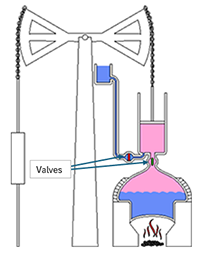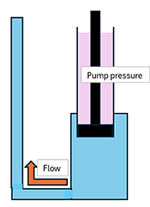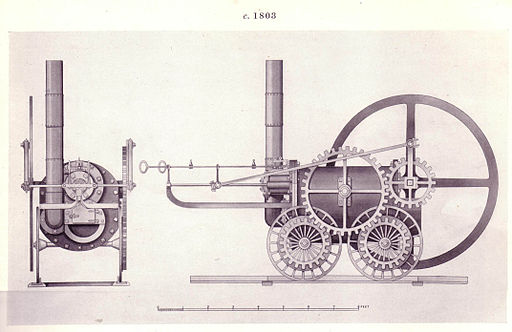From Stationary to Moving

 A beam, mounted on a pillar was rocked from side to side by the action of steam from a boiler pushing an arm up and an injection of cold water decompressing the steam to pull the arm back down. The arm on the other side only did work on the downstroke. It pushed water up a tube and released it through the top of the tube. The process was controlled by two automatic valves, one to seal the compression chamber from the boiler and the other to inject water for the decompression.
A beam, mounted on a pillar was rocked from side to side by the action of steam from a boiler pushing an arm up and an injection of cold water decompressing the steam to pull the arm back down. The arm on the other side only did work on the downstroke. It pushed water up a tube and released it through the top of the tube. The process was controlled by two automatic valves, one to seal the compression chamber from the boiler and the other to inject water for the decompression.
Hundreds of Newcomen engines were used in coal mines to pump water out of mine workings, where there was plenty of coal to feed the boiler. They were not very efficient but were the basis on which James Watt built his later steam engine. Many Newcomen engines were converted to the Watt design.
Using a cam joint, the Watt engine could be used for circular motion. This meant that it could not only power multiple stationary machines via belts or chains but could also be used in moving machines. The age of mechanised transport was about to begin.
The first moving machine was a proposed artillery tractor, invented by Nicolas-Joseph Cugnot in 1796. It was a three wheeled monster that crawled along at about 3km per hour. It was difficult to control and eventually crashed into a wall. So, the first car crash. The French military decided that they would stick with horses to pull their artillery.
 It was the Englishman, Joseph Trevithick, in 1799, who made the first road going steam engine, Puffing Devil, but it was steam engines running on rails that really dominated the first eighty or so years of mechanised transport and it was Richard Trevithick who again led the way.
It was the Englishman, Joseph Trevithick, in 1799, who made the first road going steam engine, Puffing Devil, but it was steam engines running on rails that really dominated the first eighty or so years of mechanised transport and it was Richard Trevithick who again led the way.  In 1802, the Coalbrookdale Company built a railway engine to a Trevithick design, but it was never used but, in 1808, another Trevithick design was built at Coalbrookdale. Called “Catch Me Who Can”, it was run on a circular track as an attraction in London, at a shilling a ride. The tracks were weak, and the public showed little interest.
In 1802, the Coalbrookdale Company built a railway engine to a Trevithick design, but it was never used but, in 1808, another Trevithick design was built at Coalbrookdale. Called “Catch Me Who Can”, it was run on a circular track as an attraction in London, at a shilling a ride. The tracks were weak, and the public showed little interest.
 It was the Rainhill trials which Saw the start of the railway age. They were held from 6th – 14th October 1820 on the Liverpool to Manchester railway. Five engines took part, one horse driven and four steam engines. “Rocket”, built by Robert Stephenson won easily, at an average speed of 12 miles per hour. The Liverpool to Manchester railway was recognisably modern, with a published timetable of services and termini. Liverpool also saw the first goods terminal on the South docks. The line was extended to Liverpool city centre, via a 1.6km tunnel in 1836.
It was the Rainhill trials which Saw the start of the railway age. They were held from 6th – 14th October 1820 on the Liverpool to Manchester railway. Five engines took part, one horse driven and four steam engines. “Rocket”, built by Robert Stephenson won easily, at an average speed of 12 miles per hour. The Liverpool to Manchester railway was recognisably modern, with a published timetable of services and termini. Liverpool also saw the first goods terminal on the South docks. The line was extended to Liverpool city centre, via a 1.6km tunnel in 1836.
The growth of the railways was rapid, with a complete national network laid in the ten years from 1840. British railway products and expertise were a valuable export commodity during the 19th century, with the first French and German railways operating with British locomotives. There was also increased regulation, especially safety regulation, with the Railway Inspectorate being set up in 1840 and the compulsory provision of cheap 3rd class carriages for workmen, which enabled the growth of ever larger cities.